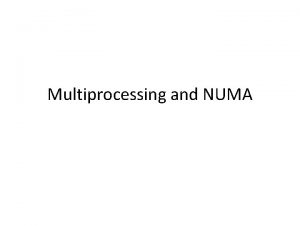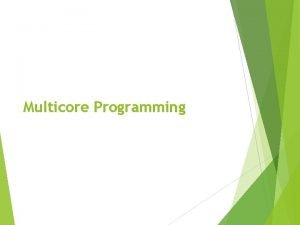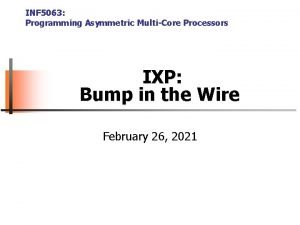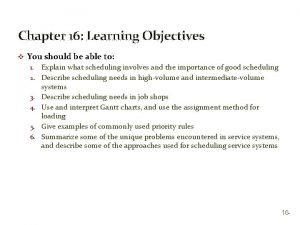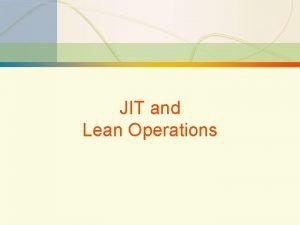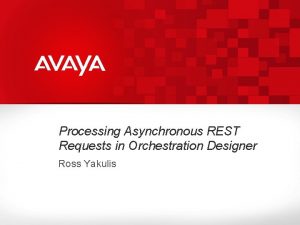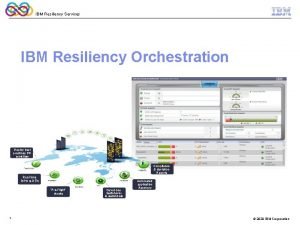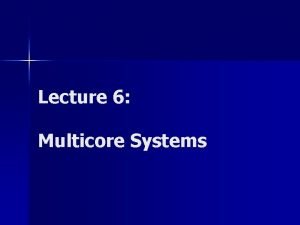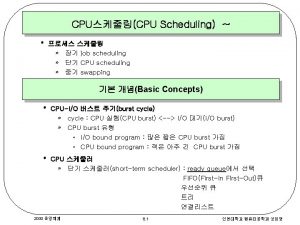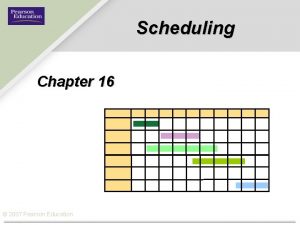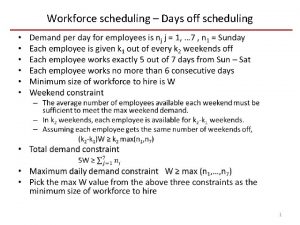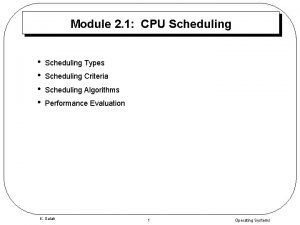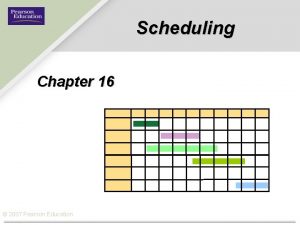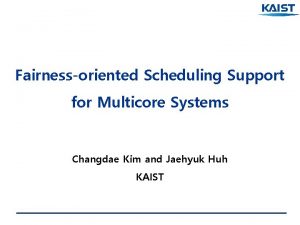Task Orchestration Scheduling and Mapping on Multicore Systems
































- Slides: 32

Task Orchestration : Scheduling and Mapping on Multicore Systems Course TBD Lecture TBD Term TBD Module developed Spring 2013 by Apan Qasem This module created with support form NSF under grant # DUE 1141022

Outline • Scheduling for parallel systems • Load balancing • Thread affinity • Resource sharing • Hardware threads (SMT) • Multicore architecture • Significance of the multicore paradigm shift TXST TUES Module: D 2 2

Increase in Transistor Count Moore’s Law TXST TUES Module: D 2 3

Increase in Performance 1000000 longer issue pipeline double speed artihmetic Improvements in chip architecture theoretical maximum performance (millions of operations per second) 100000 Increases in clock speed speculative out-oforder execution 10000 MMX (multimedia extensions) quad-core hex-core dual-core hyper threading Full Speed Level 2 Cache 3 GHz 2. 6 GHz 3. 3 GHz 2000 MHz 2. 93 GHz multiple instructions internal per cycle 733 MHz 1000 memory cache instruction 300 MHz 200 MHz pipeline 50 MHz 66 MHz 33 MHz 100 25 16 MHz 10 1986 1988 1990 1992 1994 1996 1998 2000 2002 2004 2006 2008 2010 Image adapted from Scientific American, Feb 2005, “A Split at the Core” TXST TUES Module: D 2 4

Increase in Power Density TXST TUES Module: D 2 5

The Power Wall • Going with Moore’s Law results in too much heat dissipation and power consumption • Moore’s law still holds but does not seem to be economically viable • The multicore paradigm • Put multiple simplified (and slower) processing cores on the same chip area • Fewer transistors per cm 2 implies less heat! TXST TUES Module: D 2 6

Why is Multicore Such a Big Deal? 1000000 longer issue pipeline double speed arithmetic Improvements in chip architecture Increases in clock speed theoretical maximum performance (millions of operations per second) 100000 10000 speculative out-oforder execution instruction pipeline 100 16 MHz 10 1986 25 MHz 1988 hex-core dual-core hyper threading Full Speed Level 2 Cache 3 GHz more responsibility on software 2. 6 GHz 3. 3 GHz 2000 MHz multiple instructions internal memory cache per cycle 1000 TXST TUES Module: D 2 MMX (multimedia extensions) quad-core 2. 93 GHz 733 MHz 300 MHz 200 MHz 50 MHz 66 MHz 33 MHz 1990 1992 1994 1996 1998 2000 2002 2004 2006 2008 2010 7

Why is Multicore Such a Big Deal? Parallelism is mainstream “In future, all software will be parallel” - Andrew Chien, Intel CTO (many concur) • • Parallelism no longer a matter of interest just for the HPC people Need to find more programs to parallelize Need to find more parallelism in existing parallel applications Need to consider parallelism when writing any new program TXST TUES Module: D 2 8

Why is Multicore Such a Big Deal? Parallelism is Ubiquitous TXST TUES Module: D 2 9

OS Role in the Multicore Era • There are several considerations for multicore operating systems • Scalability • Sharing and contention of resources • Non-uniform communication latency • Biggest challenge is in scheduling of threads across the system TXST TUES Module: D 2 10

Scheduling Goals • Most of the goals don’t change when scheduling for multicore or multi-processor systems • Still care about • CPU utilization • Throughput definitions may become more complex • Turnaround time • Wait time • Fairness TXST TUES Module: D 2 11

Scheduling Goals for Multicore Systems • Multicore systems give rise to a new set of goals for the OS scheduler • Load balancing • Resource sharing • Energy usage and power consumption TXST TUES Module: D 2 12

Single CPU Scheduler Overview Long-term Queue Ready Queue CPU I/O Queue TXST TUES Module: D 2 13

Multicore Scheduler Overview I Core 0 Long-term Queue Common Ready Queue Core 1 Core 2 Common I/O Queue Cores sharing the same short-term queues TXST TUES Module: D 2 Core 3 14

Multicore Scheduler Overview II Ready Queue Cores with individual ready queues Core 0 end I/O Queue Ready Queue Long-term Queue Core 1 end I/O Queue Ready Queue No special handling required for many of the single CPU scheduling algorithms Core 2 end I/O Queue Ready Queue Core 3 I/O Queue TXST TUES Module: D 2 end 15

Load Balancing 100 80 BAD 60 40 20 0 core 1 Scenario 1 TXST TUES Module: D 2 core 3 Load averag (%) over k time slices • Goal is to distribute tasks across all cores on the system such that CPU and other resources are utilized evenly • A load-balanced system will generally lead to higher throughput 100 80 GOOD 60 40 20 0 core 1 core 2 core 3 Scenario 2 16

The OS as a Load Balancer Main strategy • Identify metric for balanced load • average number of processes waiting in ready queues • (aka load average) • Track load balance metric • probe ready queues • uptime and who utilities • Migrate threads if a core exhibits a high average load • If load average for cores 0 -3 is 2, 3, 1, and 17 then move threads from core 3 to core 2 TXST TUES Module: D 2 17

Thread Migration • The process of moving a thread from one ready queue to another is known as thread migration • Operating systems implement two types of thread migration mechanism • Push migration • Run a separate process that will migrate a thread from one core to another • May be integrated within the kernel as well • Pull migration (aka work stealing) • Each core fetches threads from other cores TXST TUES Module: D 2 18

Complex Load Balancing Issues CPU Time Idle Time Assume only one thread executing on each core Core 0 (t 0) Core 1 (t 1) Core 2 (t 2) Does it help to load balance this workload? Core 3 (t 3) 0 10 20 30 40 50 time 60 70 80 90 100 Will it make a difference in performance? Thread migration or load balancing will only help with overall performance if t 1 runs faster when moved to core 0, core 2 or core 3 TXST TUES Module: D 2 19

Load Balancing for Power CPU Time Idle Time This unbalanced workload can have huge implications for power consumption Core 0 (t 0) Core 1 (t 1) Power consumption is tied to how fast a processor is running Core 2 (t 2) Core 3 (t 3) 0 10 20 30 40 50 time 60 70 80 90 100 P = cv 2 f and P t P = power, f = frequency, c = static power dissipation v = voltage and t = temperature One core running at a higher frequency than the others may result in more heat dissipation and overall increased power consumption TXST TUES Module: D 2 20

Load Balancing for Power CPU Time Idle Time • Operating Systems are incorporating power metrics in thread migration and load balancing decisions Core 0 (t 0) Core 1 (t 1) Core 2 (t 2) • Achieve power-balance by eliminating hotspots Core 3 (t 3) 0 10 20 30 40 50 time 60 70 80 90 100 Can also try to change the frequency • AMD Powernow, Intel Sidestep Can utilize hardware performance counters • core utilization • core temperature Linux implements this type of scheduling • sched_mc_power_savings TXST TUES Module: D 2 21

Load Balancing Trade-offs • Thread migration may involve multiple context switch on more than one core • Context switches can be very expensive • Potential gains from load balancing must be weighed against the increased cost from context switches • Load balancing policy may conflict with CFS scheduling • balanced load does not imply fair sharing of resources TXST TUES Module: D 2 22

Resource Sharing Current multicore and SMT systems share resources at various levels TXST TUES Module: D 2 OS needs to be aware of resource utilization in making scheduling decisions 23

Thread Affinity • Tendency for a process to run on a given core for as long as possible without being migrated to a different core • aka CPU affinity and processor affinity • The operating system uses the notion of thread affinity in performing resource-aware scheduling on multicore systems • If a thread has affinity for a specific core (or core group) then priority should be given to schedule the map and schedule thread to that specific core (or group) • Current approach is to use thread affinity to address skewed workloads • Start with default (all cores) • Set affinity of task I to core j if core j is deemed underutilized TXST TUES Module: D 2 24

Adjusting Thread Affinity • Linux kernel maintains the task_struct data structure for every process in the system • Affinity information is stored as a bitmask in the cpus_allowed field • Can modify or retrieve the affinity of a thread from userspace • sched_setaffinity(), sched_getaffinity() • pthread_setaffinity_np(), pthread_getaffinity_np() • taskset demo TXST TUES Module: D 2 25

Thread Affinity in the Linux Kernel /* Look for allowed, online CPU in same node. */ for_each_cpu_and(dest_cpu, nodemask, cpu_active_mask) if (cpumask_test_cpu(dest_cpu, &p->cpus_allowed)) return dest_cpu; /* Any allowed, online CPU? */ dest_cpu = cpumask_any_and(&p->cpus_allowed, cpu_active_mask); if (dest_cpu < nr_cpu_ids) return dest_cpu; /* No more Mr. Nice Guy. */ if (unlikely(dest_cpu >= nr_cpu_ids)) { dest_cpu = cpuset_cpus_allowed_fallback(p); /* * Don't tell them about moving exiting tasks or * kernel threads (both mm NULL), since they never * leave kernel. */ if (p->mm && printk_ratelimit()) { printk(KERN_INFO "process %d (%s) no " "longer affine to cpu%dn", task_pid_nr(p), p->comm, cpu); } Linux kernel 2. 6. 37, sched. c } TXST TUES Module: D 2 26

Affinity Based Scheduling • Affinity based scheduling can be performed under different criteria, using different heuristics • Assume 4 cores with two L 2 shared between core 0 and core 1, core 2 and core 3, L 3 shared among all cores L 3 L 2 TXST TUES Module: D 2 L 1 L 1 L 1 Core 0 Core 1 Core 2 Core 3 27

Affinity Based Scheduling P C Shared Data in L 2 time P of ta da a at fd eo eo e us us us re re re C Scheduling for data locality in L 2 • A thread ti that shares data with tj should be placed in the same affinity group • Can lead to unbalanced ready-queues but improved memory performance TXST TUES Module: D 2 28

Affinity Based Scheduling L 3 L 2 L 1 P Core 0 Poor schedule for producerconsumer program L 2 L 1 P Core 1 L 1 C Core 2 L 1 C Core 3 L 2 Good schedule for producerconsumer program L 1 L 1 P C Core 0 TXST TUES Module: D 2 L 2 Core 1 Core 2 Core 3 29

Affinity Based Scheduling • Scheduling for better cache utilization • Thread ti and tj only utilize 10% of the cache, tp and tq each demand 80% of the cache • Schedule ti and tp on core 0 and core 1, tj and tq on core 2 and core 3 • May lead to loss of locality L 3 L 2 L 1 L 1 ti tp tj tq Core 0 TXST TUES Module: D 2 L 2 Core 1 Core 2 Core 3 30

Affinity Based Scheduling for better power management • ti and tj are CPU-bound while tp and tq are memorybound • Schedule ti and tp on core 0 and tj and tq to core 2 L 3 L 2 L 1 ti + tp Core 0 TXST TUES Module: D 2 L 1 tj + tq Core 1 Core 2 Core 3 31

Gang Scheduling • Two-step scheduling process • Identify a set (or gang) of threads to and adjust affinity for them to execute in a specific core group • Gang formation can be done based on resource utilization and sharing • Suspend the threads in a gang to let one job have dedicated access to the resources for a configured period of time • Traditionally used for MPI programs running on highperformance clusters • Becoming mainstream for multicore architectures • Patches available that integrates gang scheduling with CFS in Linux TXST TUES Module: D 2 32
 Sjn scheduling
Sjn scheduling Multiprocessor and multicore
Multiprocessor and multicore Memory parameters
Memory parameters Forward mapping vs backward mapping
Forward mapping vs backward mapping Prinsip analisis dan desain
Prinsip analisis dan desain Speedy transactions in multicore in-memory databases
Speedy transactions in multicore in-memory databases Multicore packet scheduler samsung
Multicore packet scheduler samsung Multiprocessor programming
Multiprocessor programming And eat
And eat Cache craftiness for fast multicore key-value storage
Cache craftiness for fast multicore key-value storage Pxie-pcie8372
Pxie-pcie8372 Obs multicore
Obs multicore Asymmetric multicore processing
Asymmetric multicore processing Sae international
Sae international Tiered task bias task
Tiered task bias task Scheduling in high-volume systems is known by what term?
Scheduling in high-volume systems is known by what term? Scheduling in low-volume systems is known by what term?
Scheduling in low-volume systems is known by what term? Database applications
Database applications Orchestration designer
Orchestration designer Multi domain service orchestration
Multi domain service orchestration Ibm cloud resiliency
Ibm cloud resiliency Bbs
Bbs Tosca cloud orchestration
Tosca cloud orchestration Orchestration is about codifying tasks
Orchestration is about codifying tasks Hp cloud orchestration
Hp cloud orchestration Ibm resiliency orchestration sanovi
Ibm resiliency orchestration sanovi Market overview real-time interaction management
Market overview real-time interaction management Biztalk esb tutorial
Biztalk esb tutorial Conversation orchestration
Conversation orchestration Container orchestration monitoring
Container orchestration monitoring Business process orchestration
Business process orchestration Tosca orchestration
Tosca orchestration Tosca orchestration
Tosca orchestration

